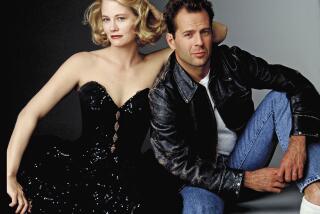This ‘Light’ Stays On : For 40 years, CBS Soap has Kept the Plots Coming and Going
- Share via
Johnny Carson may have exited the late-night airwaves, but over on daytime there’s a show that makes his run look like a flash in the pan. The CBS soap opera “Guiding Light” celebrates its 40th anniversary June 30.
“Guiding Light” had segued to television after 15 years on radio, airing on both mediums for four years. In all, it has had a 55-year run, which is the longest for a dramatic series in the history of broadcasting.
For the record:
12:00 a.m. June 28, 1992 For the Record
Los Angeles Times Sunday June 28, 1992 Orange County Edition TV Times Page 9 Television Desk 1 inches; 21 words Type of Material: Correction
In a story about the 40th anniversary of “The Guiding Light” (June 21), a photo caption reversed the names of actors Rick Hearst and Frank Dicopolous.
The show has obviously worn well: It received 16 Daytime Emmy nominations, more than any of the other 10 serials vying at Tuesday night’s Daytime Emmy Awards ceremony. It has won twice for outstanding drama series, in 1979 and 1981, and through the years has been written and produced by a “Who’s Who” of daytime heavyweights. Its acting alumni include JoBeth Williams, Kevin Bacon, Christopher Walken, James Earl Jones, Blythe Danner, Ruby Dee and Sandy Dennis.
Created by soap pioneer Irna Phillips, “Guiding Light” initially featured Arthur Peterson, who would later play the Major in the prime-time serial sendup “Soap,” as Dr. John Ruthledge, a minister in the fictional town of Five Points, Calif. The title referred to a light in the reverend’s window, beckoning those who sought his comfort and advice.
The character was eventually killed off, and upon moving to television, the Bauer family took center stage, particularly matriarch Bert, played, coincidentally, by actress Charita Bauer until her death in 1985. The series locale later became the Midwestern town of Springfield.
Nowadays, the Spauldings, Chamberlains, Lewises, Thorpes and Coopers have joined the Bauers in the spotlight, and the welcoming beacon has been replaced in the opening shot by a flashy lighthouse beam. The original 15-minute daily live format has given way to an hourlong taped version. Having survived the changes that four decades inevitably bring, just how has “Guiding Light” managed to be so successful?
One answer comes from Rick Hearst, who last year won an Emmy as outstanding younger actor for his portrayal of businessman Alan-Michael Spaulding and is nominated this year as outstanding supporting actor. “I think it’s the fact that it was a very biblically oriented, religious show, and it’s kept that solid base,” he says. “It’s about ideals and values.
“I was on ‘Days of Our Lives’ (as Scott Banning), and that dealt with fantasy locations, a deep sort of romance, love at any cost, but the circumstances were so heightened that it was difficult to get any grip on reality as an actor. On ‘Guiding Light,’ it seems to me, we take simple ideals and issues, like family and what goes on with them. It’s a little more attainable for the average viewer to identify with.”
Emmy-nominated head writer Stephen Demorest agrees: “We’re reality-based, which is the way (owner-sponsor) Procter & Gamble wants it. We’ve always done domestic dramas, not spaceships and aliens.”
Though the show does not make a point of focusing on hot issues, neither has it shied away from them. “The idea of the show was innovative,” says radio star Peterson, “because Five Points was a melting pot community. There were families of different ethnic groups--Italian, Jewish. Before that, characters were more WASPs.”
When Agnes Nixon became head writer in 1958, she created daytime television’s first major black character, nurse Martha Frazier, played by Cicely Tyson. In the 1961-62 season, Bert Bauer battled uterine cancer. More recently, Billy Lewis (portrayed by Jordan Clarke) has confronted alcoholism, paraplegic Samantha Marler (Suzy Cote) discovered what life was like in a wheelchair and Lillian Raines (Tina Sloan) had what Demorest believes to be soap opera’s first on-air mammogram, as part of a breast cancer story.
The characters have also kept pace with the times. Says Emmy-nominated supporting actress Maureen Garrett (Holly Lindsey), who left the show in 1980 after four years and returned in 1989: “When I came back, there was a change in Holly. Before, she was such a victim. She used to cower before (then-husband) Roger Thorpe. Now, she doesn’t tolerate things. She’s a strong, independent woman. She still has her quirks and her plights, still gets involved with the wrong men, but she’s a businesswoman--she runs a television station.”
The production values have improved since her last “GL” stint, Garrett adds, with more elaborate sets and glamorous wardrobe. Castmate Hearst credits Jill Farren Phelps, the show’s executive producer since last July, with bringing a crisper look to the soap.
Emmy nominee Phelps, who was previously executive producer of NBC’s “Santa Barbara,” brings a unique perspective to her position: She was a “GL” production assistant from 1975 to ’77. “We’re able to be more frank now in our storylines,” she says. “We’re not as constrained by taboos. It’s not so much that the issues have changed, but our ability has, to show the process that people go through in facing them.”
For the immediate future, Phelps promises that “the anniversary week is going to be the hottest week in Springfield history.” As for the long-term, she says, “We’ll always tell stories about the human spirit, about romance, in a way that’s as innovative, upbeat and positive as we possibly can be. Adventure stories ... and other forms of escape (on other soaps) will come and go, but viewers will always return to stories that are about relationships, love and whatever else is in their hearts.
“That’s where the staying power is.”
“Guiding Light” airs weekdays at 2 p.m. on CBS.
The Daytime Emmy Awards air Tuesday at 9 p.m. on NBC.
More to Read
The complete guide to home viewing
Get Screen Gab for everything about the TV shows and streaming movies everyone’s talking about.
You may occasionally receive promotional content from the Los Angeles Times.






